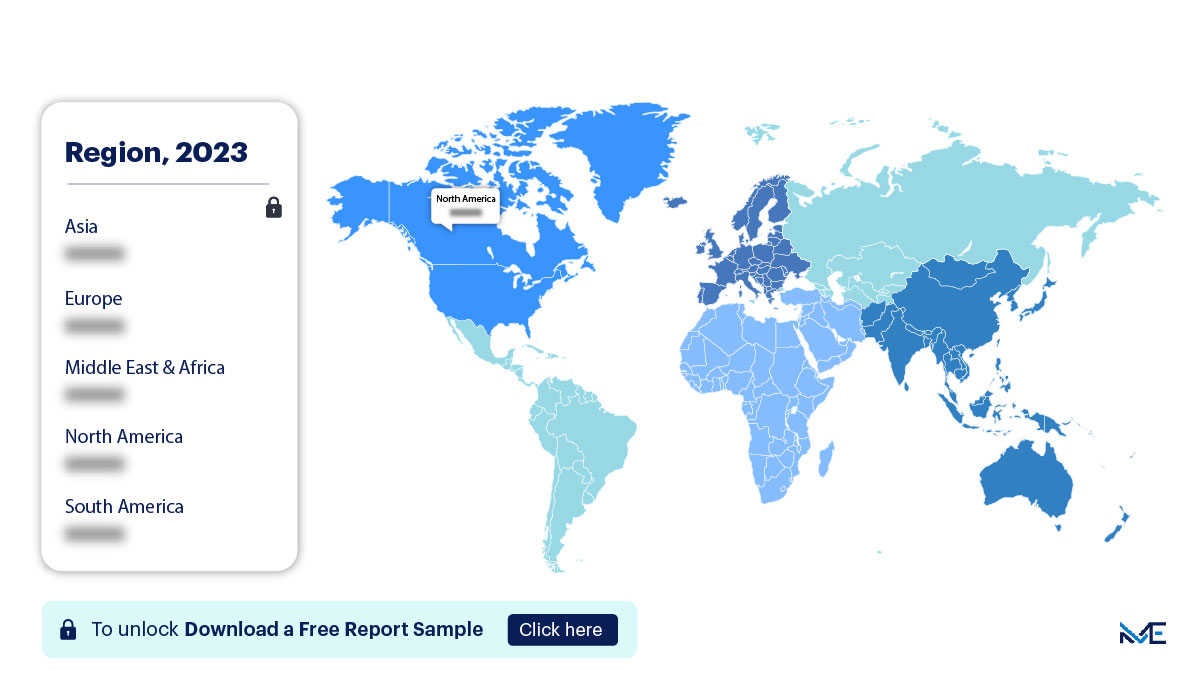
Calcium Market Size and Analysis by Type (Calcium Chloride, Calcium Carbonate, Calcium Silicate, Calcium Propionate, Others) and by Application (Food Beverages, Pharmaceutical, Construction, Paper Production, Oil And Gas, Others): Global Opportunity & Industry Forecast, 2024-2032
- Report ID: ME_00132416
- Format: Electronic (PDF)
- Publish Type: Publish
- Number of Pages: 250
Market Snapshot
| Study Period | 2019-2032 |
| Base Year | 2023 |
| Forcast Year | 2023-2032 |
| CAGR | 6.9 |


Gain accurate insights regarding the negative impacts of COVID-19 on all markets and industries
Download Sample PdfReport Overview
Calcium Market Analysis Report 2024-2032:
The Calcium Market size is estimated to grow at a CAGR of 5.6% between 2024 and 2032. The growth of the market depends on several factors, including the rise in demand for calcium supplements, increasing adoption of calcium-fortified food and beverages, and growing awareness about the importance of calcium in maintaining bone health and overall well-being. Calcium is a vital mineral that plays a crucial role in various physiological functions in the human body. It is essential for the development and maintenance of strong bones and teeth, muscle function, blood clotting, and more.
Calcium Market Overview:
Drivers
One of the key factors driving the calcium market growth is the increasing demand for calcium supplements. As people become more health-conscious, the need for calcium supplementation has risen significantly. Calcium supplements are used to meet the daily calcium requirements, especially in cases where dietary intake is insufficient. This has resulted in substantial growth in the global calcium market, as consumers seek ways to maintain their bone health and overall well-being.
Moreover, the calcium market benefits from the integration of calcium-fortified products in the food and beverage industry. Calcium-fortified foods and beverages offer consumers a convenient way to incorporate this essential mineral into their diet. This trend has been particularly prominent in dairy alternatives, plant-based beverages, and fortified cereals. The growing awareness of the importance of calcium in maintaining bone health and preventing conditions like osteoporosis has further fueled the demand for such products.
Trends
A key factor shaping the calcium market growth is the innovation in calcium delivery methods. Manufacturers are constantly exploring novel ways to deliver calcium to consumers. This includes the development of calcium-fortified gummies, chews, and liquid supplements, which offer a more enjoyable and convenient way to consume calcium. These innovations cater to consumers who may have difficulty swallowing traditional calcium pills or tablets.
Additionally, the calcium market benefits from the increasing adoption of calcium-fortified plant-based products. With the rising popularity of plant-based diets, there is a growing demand for calcium-fortified alternatives to traditional dairy products. Manufacturers are responding by fortifying products like almond milk, soy milk, and plant-based yogurts with calcium to provide consumers with viable options that align with their dietary preferences and lifestyle choices.
Restraints
One of the challenges hindering the calcium market growth is the potential for calcium overdose or adverse effects. Excessive calcium intake can lead to health issues, including kidney stones and gastrointestinal problems. As consumers become more health-conscious and self-medicate with supplements, there is a risk of unintentional overconsumption. Educating consumers about the appropriate dosage and the importance of consulting healthcare professionals before starting any supplementation regimen is crucial to avoid these issues.
Furthermore, regulatory constraints and standards related to calcium fortification vary from one region to another, posing a challenge for manufacturers looking to market their calcium-fortified products globally. Navigating these regulatory hurdles and ensuring compliance with local standards can be complex and costly for businesses operating in the calcium market.
Calcium Market Segmentation by Application
The calcium supplements segment is estimated to witness significant growth during the forecast period. Calcium supplements are widely used to address calcium deficiencies in individuals, especially those who are at risk of osteoporosis or other bone-related conditions. These supplements are available in various forms, including calcium carbonate and calcium citrate, providing consumers with choices based on their dietary needs and preferences. The calcium supplements segment is expected to grow as more people seek convenient ways to meet their daily calcium requirements.
Calcium-fortified food and beverages are another essential application segment within the calcium market. Calcium fortification is prevalent in a wide range of products, such as dairy alternatives, fortified orange juice, and breakfast cereals. The addition of calcium enhances the nutritional value of these products, making them attractive to consumers seeking to boost their calcium intake while enjoying their favorite foods and beverages.
Calcium Market Segmentation by Type
The calcium carbonate segment is poised for significant growth in the calcium market. Calcium carbonate is one of the most common forms of calcium used in supplements and as a food additive. It offers a cost-effective and bioavailable source of calcium, making it a popular choice for manufacturers. Consumers appreciate the versatility of calcium carbonate, as it can be found in a variety of products, from antacids to calcium supplements.
Calcium citrate is another notable segment in the calcium market. It is often chosen for its superior bioavailability, making it an excellent option for individuals with conditions that affect calcium absorption. Calcium citrate is widely used in calcium supplements and fortified products to ensure that consumers can effectively absorb and utilize the calcium they consume.
Regional Overview:

Download the report summary now!
Request pdf Sample
North America is estimated to contribute 38% to the growth of the global calcium market during the forecast period. The region's market growth is driven by the presence of a health-conscious consumer base and a well-established dietary supplement industry. The United States and Canada, in particular, have a high demand for calcium supplements and fortified products. Consumers in North America prioritize bone health and are willing to invest in products that support it.
Europe also plays a significant role in the calcium market, contributing to around 28% of its growth. Countries like the United Kingdom, Germany, and France have a strong market for calcium-fortified foods and beverages. European consumers are increasingly embracing fortified products that cater to their dietary preferences and lifestyles.
In 2020, during the COVID-19 pandemic, the calcium market experienced disruptions in supply chains, impacting the availability of calcium supplements and fortified products. However, with the gradual easing of restrictions and increased vaccination efforts, the market has rebounded, and consumers continue to seek ways to enhance their health and well-being through calcium intake.
Calcium Market Customer Landscape
The calcium market industry report includes an analysis of the adoption lifecycle of the market, covering from innovators to laggards. It focuses on regional adoption rates and provides insights into key purchase criteria and drivers of price sensitivity to help companies develop and evaluate their growth strategies.
Who are the Major Calcium Market Companies? Companies in the calcium market are employing various strategies to enhance their market presence. These strategies include forming strategic alliances, entering partnerships, mergers and acquisitions, expanding their geographical reach, and launching new products and services.
The research report also provides detailed analyses of the competitive landscape of the calcium market, offering information about key market players. It profiles 15 market companies, including:
- CalciCorp Inc.
- NutraVitamins Ltd.
- DairyRich Foods
- CalciumPlus Solutions
- HealthyLife Brands
- NutriEssentials Group
- VitaMinerals International
- Nature's Best Calcium
- PureSource Supplements
- LifeStrong Nutraceuticals
Qualitative and quantitative analyses of these companies help clients gain a deeper understanding of the broader business environment and the strengths and weaknesses of key market players. The analysis categorizes companies as pure play, category-focused, industry-focused, or diversified, and also assesses their dominance and competitive strength in the market.
Segment Overview The calcium market report provides revenue forecasts at the global, regional, and country levels. It also offers an analysis of the latest trends and growth opportunities in the calcium market from 2024 to 2032.
Market Segmentation:
- Application Outlook (USD Million, 2024 - 2032)
- Calcium Supplements
- Calcium-Fortified Food and Beverages
- Type Outlook (USD Million, 2024 - 2032)
- Calcium Carbonate
- Calcium Citrate
- Geography Outlook (USD Million, 2024 - 2032)
- North America
- The U.S.
- Canada
- Europe
- U.K.
- Germany
- France
- Rest of Europe
- APAC
- China
- India
- South America
- Chile
- Argentina
- Brazil
- Middle East & Africa
- Saudi Arabia
- South Africa
- Rest of the Middle East & Africa
- North America
RESEARCH METHODOLOGY
A research methodology is a systematic approach for assessing or conducting a market study. Researchers tend to draw on a variety of both qualitative and quantitative study methods, inclusive of investigations, survey, secondary data and market observation.
Such plans can focus on classifying the products offered by leading market players or simply use statistical models to interpret observations or test hypotheses. While some methods aim for a detailed description of the factors behind an observation, others present the context of the current market scenario.
Now let’s take a closer look at the research methods here.
Secondary Research Model
Extensive data is obtained and cumulated on a substantial basis during the inception phase of the research process. The data accumulated is consistently filtered through validation from the in-house database, paid sources as well reputable industry magazines. A robust research study requires an understanding of the overall value chain. Annual reports and financials of industry players are studied thoroughly to have a comprehensive idea of the market taxonomy.
Primary Insights
Post conglomeration of the data obtained through secondary research; a validation process is initiated to verify the numbers or figures. This process is usually performed by having a detailed discussion with the industry experts.
However, we do not restrict our primary interviews only to the industry leaders. Our team covers the entire value chain while verifying the data. A significant number of raw material suppliers, local manufacturers, distributors, and stakeholders are interviewed to make our findings authentic. The current trends which include the drivers, restraints, and opportunities are also derived through the primary research process.
Market Estimation
The market estimation is conducted by analyzing the data collected through both secondary and primary research. This process involves market breakdown, bottom-up and top- down approach.
Moreover, while forecasting the market a comprehensive statistical time series model is designed for each market. Macroeconomic indicators are considered to understand the current trends of the market. Each data point is verified by the process of data triangulation method to arrive at the final market estimates.
Final Presentation
The penultimate process results in a holistic research report. The study equips key industry players to undertake significant strategic decisions through the findings. The report encompasses detailed market information. Graphical representations of the current market trends are also made available in order to make the study highly comprehensible for the reader.
Personalized Business Report Tailored to Your Requirements
- Our expert analysts collaborate directly with you to comprehend your specific needs.
- Get data on regions, segments, competitors, and vendors of your choice.
- Information is presented in alignment with your exact preferences and formatting.
Free Sample Report
"Find new revenue generation opportunities"
